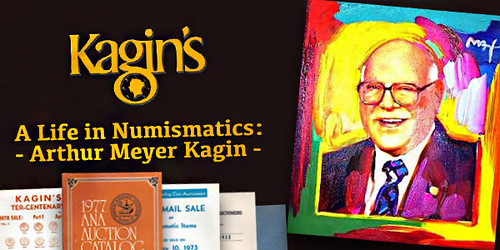
PREV ARTICLE
NEXT ARTICLE
FULL ISSUE
PREV FULL ISSUE
ARTHUR MEYER KAGIN 1919-2005
David Alexander published a nice article on the life of coin dealer dealer Art Kagin in CoinWeek on October 8, 2015. Here's an
excerpt, but be sure to read the complete version online. -Editor

For generations he was among America’s best-known professional numismatists and was widely eulogized upon his death on July 18, 2005. Arthur Meyer Kagin was born in Minneapolis on Nov. 25, 1919. His mother was widowed after the birth of his brother and long-time numismatic partner Paul in 1921. His parents had made the trans-Atlantic voyage from Russia with thousands of other Russian Jews during the great flood tide of immigration before the First World War. Most Jewish immigrants in that busy era settled in the East, notably in New York, but a number of more adventurous families settled in the Midwest, in cities such as Chicago and Milwaukee. Art’s mother went even further west, marrying a man named Schreiber in Omaha, Nebraska and presenting Art with two half-brothers later associated with the coin dealership to which he devoted his life. Since their last name was not Kagin, the Schreibers were not easily identified on the show circuit as family, often a useful situation. Art was fond of telling the story of his introduction to the world of coins in 1928. He and each of his four brothers had separate corners where they each sold newspapers and magazines. Art told the story that once an older lady paid him with an 1883 No Cents Liberty head “V” nickel with instructions to keep it safe as it would one day be worth far more than five cents, since it lacked the word ‘cents’. This anecdote was the origin of the cryptic “Art Kagin – since 1928” that appeared for decades under his photograph in Kagin ads in The Numismatist and Numismatic Scrapbook magazines. Art took a momentous step at age 13, going to work for R.O. Hollinbeck Stamp & Coin in Minneapolis in 1933. Starting as a weekend and summer worker, he went full time in 1935. He rose with amazing speed, assuming heavy responsibilities for a teenager, opening Hollinbeck stores in Omaha and in 1936 in Des Moines, Iowa, where he would remain for a lifetime. Des Moines was a city of good size, a state capital and railroad hub. It was also a growing business and financial center, home to so many insurance companies that it drew the nickname “the Hartford of the West.” Cost of living was more reasonable than New York and in short order, Art Kagin placed it on the numismatic map. The Great Depression launched thousands of Americans into coin collecting, especially after J.K. Post of Neenah, Wisconsin, created the first “penny boards” later acquired and perfected by Whitman Publishing of Racine. However dismal the economy might be, nearly everyone could set aside a few Lincoln cents to fill the holes in these inexpensive boards and resell the filled boards to local coin dealers. Art’s Des Moines store sold more than 50,000 boards annually and distributed thousands more through five-and-ten-cent stores, even barber shops and drug stores. Iowa coin clubs now proliferated from zero in the 1920’s to 20 in 1938, when the Iowa Numismatic Association was formed as the first state organization in the U.S. In 1940 the Central States Numismatic Society was created with Art’s active participation. Art’s younger brother Paul joined the firm in 1940, but the name Hollinbeck Stamp and Coin Company continued to be used for decades after sale of the firm to the Kagins. In part this name was preserved for its familiarity to customers, but there was a second reason relating to a dark reality in American life at that time: it didn’t “sound Jewish.” Anti-Semitism was a pervasive undercurrent in pre-war America and there were many businesses whose names were chosen with this in mind. Art’s youngest son Don joined the firm full time in 1972. The year 1973 saw far-reaching change. What was billed as the “Ter-Centenary Sale, Part I” in April included a set of pale red U.S. gold dollar photos on the front cover. The firm name is given as Hollinbeck KAGIN Coin Company and “Meet the Catalogers” now includes a third photo, Don Kagin. There are still no lot photos inside the 64 page catalog.
The November sale was held in Harrisburg, Pa., at the convention of the Middle Atlantic Numismatic Association (MANA). For the first time, seven black and white plates of exceptionally poor visual quality were included along with a very few dropped-in photos “of the actual items sold.” Highlights included a rare 1841 No Drapery dime, 1792 Birch Cent and an 1894-S Barber Dime and a silver plated copper electrotype 1804 Silver Dollar made in the Philadelphia mint by W.E. DuBois. To read the complete article, see:
Wayne Homren, Editor The Numismatic Bibliomania Society is a non-profit organization promoting numismatic literature. See our web site at coinbooks.org. To submit items for publication in The E-Sylum, write to the Editor at this address: whomren@gmail.com To subscribe go to: https://my.binhost.com/lists/listinfo/esylum All Rights Reserved. NBS Home Page Contact the NBS webmaster 
|
